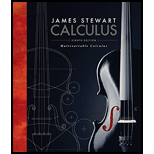
Concept explainers
(a) Write the general form of a second-order homogeneous linear differential equation with constant coefficients.
(b) Write the auxiliary equation.
(c) How do you use the roots of the auxiliary equation to solve the differential equation? Write the form of the solution for each of the three cases that can occur.
(a)
To write: The general form of a second-order homogeneous linear differential equation with constant coefficients.
Answer to Problem 1RCC
The general form of a second-order homogeneous linear differential equation with constant coefficients is
Explanation of Solution
Formula used:
Consider the second-order linear differential equation as follows.
Here,
If
Consider the value of
Substitute
Consider
Substitute
Thus, the general form of a second-order homogeneous linear differential equation with constant coefficients is
(b)
To write: The auxiliary equation.
Answer to Problem 1RCC
The auxiliary equation of the second-order differential equation is
Explanation of Solution
Modify equation (3) as follows.
In equation (4), function
Consider a exponential function for
Differentiate
Differentiate
Substitute
Since, the value of
Equation (6) is known as characteristic equation or auxiliary equation of the second-order differential equation
Thus, the auxiliary equation of the second-order differential equation is
(c)
To explain: The use of roots of the auxiliary equation to solve the differential equation and write the form of the solution for each of the three cases.
Answer to Problem 1RCC
The use of roots of the auxiliary equation to solve the differential equation is explained.
The form of the solution for each of the three cases is written.
Explanation of Solution
Formula used:
Consider the second-order differential equation as follows.
Write the expression for quadratic formula.
Modify equation (7) as follows.
Modify equation (8) as follows.
Thus, the use of roots of the auxiliary equation to solve the differential equation is explained.
Three different cases are obtained depending upon the term
Case I:
Consider the value of
In this case, the roots of auxiliary equation are real and distinct. So two linear independent solutions are occurs such as
Write the expression for general solution.
Here,
Substitute
Case II:
Consider the value of
In this case, the roots of auxiliary equation are real and equal.
Consider
Substitute
Case III:
Consider the value of
In this case, the roots of auxiliary equation are complex numbers.
Consider
Write the expression for general solution with complex roots.
Thus, the form of the solution for each of the three cases is written.
Want to see more full solutions like this?
Chapter 17 Solutions
Multivariable Calculus
 Calculus: Early TranscendentalsCalculusISBN:9781285741550Author:James StewartPublisher:Cengage Learning
Calculus: Early TranscendentalsCalculusISBN:9781285741550Author:James StewartPublisher:Cengage Learning Thomas' Calculus (14th Edition)CalculusISBN:9780134438986Author:Joel R. Hass, Christopher E. Heil, Maurice D. WeirPublisher:PEARSON
Thomas' Calculus (14th Edition)CalculusISBN:9780134438986Author:Joel R. Hass, Christopher E. Heil, Maurice D. WeirPublisher:PEARSON Calculus: Early Transcendentals (3rd Edition)CalculusISBN:9780134763644Author:William L. Briggs, Lyle Cochran, Bernard Gillett, Eric SchulzPublisher:PEARSON
Calculus: Early Transcendentals (3rd Edition)CalculusISBN:9780134763644Author:William L. Briggs, Lyle Cochran, Bernard Gillett, Eric SchulzPublisher:PEARSON Calculus: Early TranscendentalsCalculusISBN:9781319050740Author:Jon Rogawski, Colin Adams, Robert FranzosaPublisher:W. H. Freeman
Calculus: Early TranscendentalsCalculusISBN:9781319050740Author:Jon Rogawski, Colin Adams, Robert FranzosaPublisher:W. H. Freeman
 Calculus: Early Transcendental FunctionsCalculusISBN:9781337552516Author:Ron Larson, Bruce H. EdwardsPublisher:Cengage Learning
Calculus: Early Transcendental FunctionsCalculusISBN:9781337552516Author:Ron Larson, Bruce H. EdwardsPublisher:Cengage Learning





